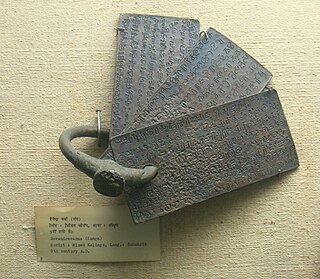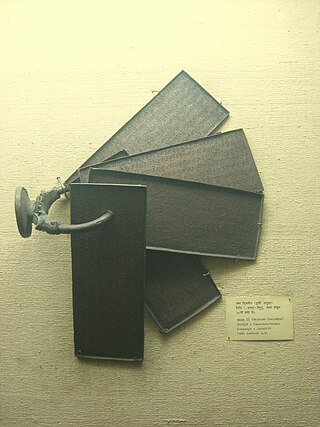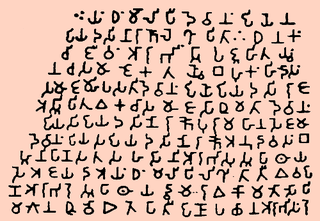
Sanchi Stupa is a Buddhist complex, famous for its Great Stupa, on a hilltop at Sanchi Town in Raisen District of the State of Madhya Pradesh, India. It is located, about 23 kilometers from Raisen town, district headquarter and 46 kilometres (29 mi) north-east of Bhopal, capital of Madhya Pradesh.

Brahmi is a writing system of ancient India that appeared as a fully developed script in the 3rd century BCE. Its descendants, the Brahmic scripts, continue to be used today across Southern and Southeastern Asia.
Telugu script, an abugida from the Brahmic family of scripts, is used to write the Telugu language, a Dravidian language spoken in the Indian states of Andhra Pradesh and Telangana as well as several other neighbouring states. It is one of the official scripts of the Indian Republic. The Telugu script is also widely used for writing Sanskrit texts and to some extent the Gondi language. It gained prominence during the Eastern Chalukyas also known as Vengi Chalukya era. It shares extensive similarities with the Kannada script, as both of them evolved from the Bhattiprolu and Kadamba scripts of the Brahmi family. In 2008, the Telugu language was given the status of a Classical Language of India, in recognition of its rich history and heritage.

The Kharoṣṭhī script, also known as the Gāndhārī script, was an ancient Indic script used by various peoples from the north-western outskirts of the Indian subcontinent to Central Asia via Afghanistan. An abugida, it was introduced at least by the middle of the 3rd century BCE, possibly during the 4th century BCE, and remained in use until it died out in its homeland around the 3rd century CE.

The Satavahanas, also referred to as the Andhras in the Puranas, were an ancient Indian Brahmin dynasty based in the Deccan region. Most modern scholars believe that the Satavahana rule began in the late second century BCE and lasted until the early third century CE, although some assign the beginning of their rule to as early as the 3rd century BCE based on the Puranas, but uncorroborated by archaeological evidence. The Satavahana kingdom mainly comprised the present-day Andhra Pradesh, Telangana, and Maharashtra. At different times, their rule extended to parts of modern Gujarat, Madhya Pradesh, and Karnataka. The dynasty had different capital cities at different times, including Kotalingala(Telangana), Pratishthana (Paithan) and Amaravati (Dharanikota).

Bharhut is a village located in the Satna district of Madhya Pradesh, central India. It is known for its famous relics from a Buddhist stupa. What makes Bharhut panels unique is that each panel is explicitly labelled in Brahmi characters mentioning what the panel depicts. The major donor for the Bharhut stupa was King Dhanabhuti.

Since the Iron Age in India, the native languages of the Indian subcontinent are divided into various language families, of which the Indo-Aryan and the Dravidian are the most widely spoken. There are also many languages belonging to unrelated language families such as Munda and Tibeto-Burman, spoken by smaller groups.

Bhattiprolu is a village in Bapatla district of the Indian state of Andhra Pradesh. It is the headquarters of Bhattiprolu mandal in Tenali revenue division. The Buddhist stupa in the village is one of the centrally protected monuments of national importance. One of the earliest evidence of Brahmi script in South India comes from Bhattiprolu. The script was written on an urn containing Buddha's relics. The script has been named Bhattiprolu script.

Nagarjunakonda: Nāgārjunikoṇḍa, meaning Nagarjuna Hill) is a historical town, now an island located near Nagarjuna Sagar in Palnadu district of the Indian state of Andhra Pradesh. It is one of India's richest Buddhist sites, and now lies almost entirely under the lake created by the Nagarjuna Sagar Dam. With the construction of the dam, the archaeological relics at Nagarjunakonda were submerged, and had to be excavated and transferred to higher land, which has become an island.

Tamil-Brahmi, also known as Tamili or Damili, was a variant of the Brahmi script in southern India. It was used to write inscriptions in the early form of Old Tamil. The Tamil-Brahmi script has been paleographically and stratigraphically dated between the third century BCE and the first century CE, and it constitutes the earliest known writing system evidenced in many parts of Tamil Nadu, Kerala, Andhra Pradesh and Sri Lanka. Tamil Brahmi inscriptions have been found on cave entrances, stone beds, potsherds, jar burials, coins, seals, and rings.

The earliest undisputed deciphered epigraphy found in the Indian subcontinent are the Edicts of Ashoka of the 3rd century BCE, in the Brahmi script.

The Kalinga script or Southern Nagari is a Brahmic script used in the region of what is now modern-day Odisha, India and was primarily used to write Odia language in the inscriptions of the kingdom of Kalinga which was under the reign of early Eastern Ganga dynasty. By the 12th century, with the defeat of the Somavamshi dynasty by the Eastern Ganga monarch Anantavarman Chodaganga and the subsequent reunification of the Trikalinga(the three regions of ancient Odra- Kalinga, Utkala and Dakshina Koshala) region, the Kalinga script got replaced by the Siddhaṃ script-derived Proto-Oriya script which became the ancestor of the modern Odia script.

The Indo-Greeks practiced numerous religions during the time they ruled in the northwestern Indian subcontinent from the 2nd century BCE to the beginning of the 1st century CE. In addition to the worship of the Classical pantheon of the Greek deities found on their coins, the Indo-Greeks were involved with local faiths, particularly with Buddhism, but also with Hinduism and Zoroastrianism.

The Telugu–Kannada script was a writing system used in Southern India. Despite some significant differences, the scripts used for the Telugu and Kannada languages remain quite similar and highly mutually intelligible. Satavahanas and Chalukyas influenced the similarities between Telugu and Kannada scripts.

Bavikonda Buddhist Complex lies about 16 km from Visakhapatnam, in the Indian state of Andhra Pradesh, on a hill about 130 metres above mean sea level. The term Bavikonda in Telugu means a hill of wells. As per its name, Bavikonda is a hill which has wells for the collection of rainwater. Bavikonda Monastic ruins dates back to the 3rd century BCE.

Lipi means 'writing, letters, alphabet', and contextually refers to scripts, the art or manner of writing, or in modified form such as lipī to painting, decorating or anointing a surface to express something.
The Northern Satraps, or sometimes Satraps of Mathura, or Northern Sakas, are a dynasty of Indo-Scythian ("Saka") rulers who held sway over the area of Punjab and Mathura after the decline of the Indo-Greeks, from the end of the 1st century BCE to the 2nd century CE. They are called "Northern Satraps" in modern historiography to differentiate them from the "Western Satraps", who ruled in Sindh, Gujarat and Malwa at roughly the same time and until the 4th century CE. They are thought to have replaced the last of the Indo-Greek kings in the Punjab region, as well as the Mitra dynasty and the Datta dynasty of local Indian rulers in Mathura.

The Stupa No. 2 at Sanchi, also called Sanchi II, is one of the oldest existing Buddhist stupas in India, and part of the Buddhist complex of Sanchi in Madhya Pradesh. It is of particular interest since it has the earliest known important displays of decorative reliefs in India, probably anterior to the reliefs at the Mahabodhi Temple in Bodh Gaya, or the reliefs of Bharhut. It displays what has been called "the oldest extensive stupa decoration in existence". Stupa II at Sanchi is therefore considered as the birthplace of Jataka illustrations.
Girihandu Seya is an ancient Buddhist temple situated in Thiriyai, Trincomalee, Sri Lanka. The temple is supposed to be the first Buddhist Stupa in Sri Lanka, believed to be constructed by two seafaring merchants Trapusa and Bahalika. The names of the two merchants are recorded in a rock inscription found in the Vihara premises. According to the inscription, Girihandu Seya was built by the guilds of merchants named Trapassuka and Vallika where the names are written as Tapassu and Bhalluka in later Sinhala chronicles. Some scholars also hold the view that Mahayana influenced seafaring merchants from the Pallava Kingdom were responsible for the construction of this temple.

The Nasik inscription of Ushavadata is an inscription made in the Nasik Caves by Ushavadata, a son-in-law of the Western Satraps ruler Nahapana, in the years circa 120 CE. It is the earliest known instance of the usage of Sanskrit, although a rather hybrid form, in western India. It also documents the Indian tradition of dana (charity) to Brahmins, Buddhists and of building infrastructure to serve pilgrims and the general public by the 2nd-century CE.



















